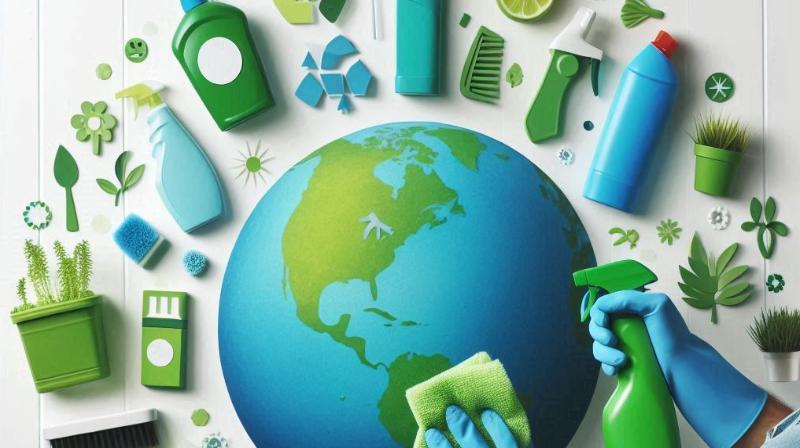Ditch the harsh chemicals! Discover 5 easy cleaning products you can swap for Natural Cleaning alternatives today. Simple DIY recipes included for a healthier, greener home.

Natural Cleaning Alternatives
Ever scrubbed your kitchen counters with a cleaner so strong it practically took your breath away? Or maybe the “fresh scent” of your bathroom spray is enough to make your eyes water?
Many conventional cleaning products rely on harsh chemicals and artificial fragrances that can be irritating, or even harmful, to our health and the environment. But the good news is there’s a better way!
Embrace the power of natural cleaning alternatives – simple, effective, and eco-friendly solutions that will leave your home sparkling without the harsh side effects.
Five common cleaning products you can easily swap out for natural alternatives today
| Conventional Cleaner | Natural Alternative | Key Ingredients |
|---|---|---|
| All-Purpose Cleaner | DIY Vinegar Solution | White vinegar, water, essential oils (optional) |
| Drain Cleaner | Baking Soda & Vinegar | Baking soda, white vinegar |
| Antibacterial Spray | Hydrogen Peroxide Solution | 3% Hydrogen Peroxide, water |
| Furniture Polish | Olive Oil & Lemon Juice | Olive oil, lemon juice |
| Scouring Powder | Baking Soda Paste | Baking soda, water |
1. Ditch the All-Purpose Cleaner for a Vinegar Solution
Conventional all-purpose cleaners often contain a cocktail of chemicals that can trigger allergies, irritate sensitive skin, and pollute the air.
Fortunately, a simple vinegar solution can achieve the same cleaning power without the drawbacks. Simply mix equal parts white vinegar and water in a spray bottle.
Vinegar is a natural disinfectant and deodorizer, effectively cutting through grease and grime while leaving surfaces sparkling clean.
Worried About the Vinegar Smell?
Here are a few essential oils that are great for adding a fresh scent and antibacterial properties to your DIY cleaners:
- Lemon
- Tea Tree
- Lavender
- Eucalyptus
- Peppermint
2. Trade Chemical Drain Cleaners for Baking Soda and Vinegar
Chemical drain cleaners are notoriously caustic, capable of damaging pipes and posing risks to both human and animal health. Instead, opt for a safer and equally effective solution: baking soda and vinegar. Pour one cup of baking soda down the drain, followed by one cup of white vinegar. The fizzing action created by this combination helps to loosen clogs and break down buildup. Allow the mixture to work its magic for about 30 minutes, then flush with hot water for a clear drain.
3. Replace Antibacterial Sprays with Hydrogen Peroxide
Many antibacterial sprays rely on triclosan, a chemical linked to potential health concerns and antibiotic resistance. A safer alternative is a simple hydrogen peroxide solution. Mix 3% hydrogen peroxide with an equal part of water in a spray bottle. Hydrogen peroxide is a natural disinfectant, effectively killing bacteria and viruses without the use of harsh chemicals.
4. Swap Furniture Polish for Olive Oil and Lemon Juice
Commercial furniture polishes often contain solvents and volatile organic compounds (VOCs) that can be harmful to indoor air quality. A natural and effective alternative is a mixture of olive oil and lemon juice. Combine 1/4 cup olive oil with 2 tablespoons of lemon juice. Apply a small amount to a soft cloth and buff into the wood. Olive oil conditions and protects the wood, while lemon juice cleans and adds shine.
5. Choose Baking Soda Paste Over Scouring Powder
Conventional scouring powders can be abrasive, potentially scratching surfaces and releasing dust particles into the air. A gentler yet equally effective solution is a baking soda paste. Simply mix baking soda with a small amount of water to form a paste. Apply the paste to surfaces and scrub with a sponge or cloth. Baking soda is a mild abrasive that effectively removes grime and stains without damaging delicate surfaces.
Additional Tips & Benefits
Beyond these five simple swaps, there’s even more you can do to embrace natural cleaning. Microfiber cloths are a fantastic tool for eco-friendly cleaning. Their unique fibers effectively pick up dirt and grime with just water, often eliminating the need for any cleaning products at all.
But the benefits of making the switch to natural cleaning alternatives extend far beyond just a cleaner home. Here are just a few advantages to consider:
Bonus Tip: Microfiber cloths are a natural cleaning powerhouse! Their unique fibers effectively pick up dirt and grime with just water, reducing the need for cleaning products altogether.
Benefits of Natural Cleaning
- Healthier Home: Reduce exposure to harsh chemicals and potential allergens that can irritate skin, eyes, and lungs.
- Eco-Friendly: Minimize your impact on the environment by using biodegradable ingredients and reducing plastic waste from store-bought cleaners.
- Cost-Effective: Save money by creating your own cleaners with inexpensive ingredients readily available in most pantries.
- Simple & Easy: Most DIY natural cleaners require only a few ingredients and minimal effort to prepare, making them a convenient and accessible option for everyone.
By choosing natural cleaning alternatives, you’re not only taking care of your home, but you’re also investing in your health and the well-being of the planet.
Recap
So ditch the toxic cleaners and embrace the power of nature! You’ll be amazed by how easy and effective it is to create a clean and healthy home with simple, natural ingredients. Why not try one of these swaps today and see the difference for yourself? Your home, your health, and the planet will thank you.
For more natural cleaning recipes and tips, explore online resources and discover a world of eco-friendly cleaning solutions. You’ll find a wealth of information on creating your own cleaning products using ingredients like essential oils, vinegar, baking soda, and castile soap. Happy cleaning!
Resources
Read the Label First: Protect Your Kids | US EPA. US EPA. Published April 11, 2014. Accessed May 19, 2024. https://www.epa.gov/safepestcontrol/read-label-first-protect-your-kids